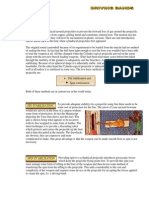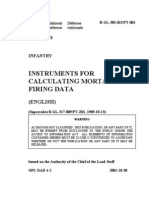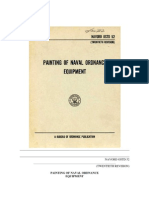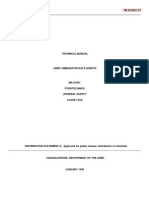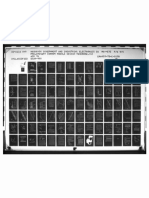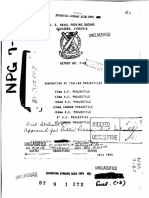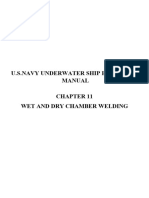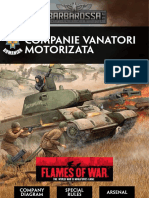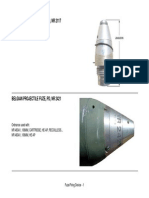0 ratings0% found this document useful (0 votes)
600 viewsEM 385-1-97 Chg01
EM 385-1-97 Chg01
Uploaded by
Jonn DoughThis document provides changes and updates to the US Army Corps of Engineers Safety and Health Requirements Manual regarding safety requirements for working with munitions and explosives of concern (MEC). It rescinds and consolidates duplicative information from other manuals and appendices. The document outlines new requirements for conducting a MEC probability assessment to determine the likelihood of encountering unexploded ordnance at a work site and the appropriate level of support and safety procedures required. It details procedures to follow if MEC is encountered, including stopping work, marking the location, and reporting the finding to authorities.
Copyright:
© All Rights Reserved
Available Formats
Download as PDF, TXT or read online from Scribd
EM 385-1-97 Chg01
EM 385-1-97 Chg01
Uploaded by
Jonn Dough0 ratings0% found this document useful (0 votes)
600 views32 pagesThis document provides changes and updates to the US Army Corps of Engineers Safety and Health Requirements Manual regarding safety requirements for working with munitions and explosives of concern (MEC). It rescinds and consolidates duplicative information from other manuals and appendices. The document outlines new requirements for conducting a MEC probability assessment to determine the likelihood of encountering unexploded ordnance at a work site and the appropriate level of support and safety procedures required. It details procedures to follow if MEC is encountered, including stopping work, marking the location, and reporting the finding to authorities.
Original Description:
Explosives Safety and Health Requirements Manual
Original Title
EM_385-1-97_Chg01
Copyright
© © All Rights Reserved
Available Formats
PDF, TXT or read online from Scribd
Share this document
Did you find this document useful?
Is this content inappropriate?
This document provides changes and updates to the US Army Corps of Engineers Safety and Health Requirements Manual regarding safety requirements for working with munitions and explosives of concern (MEC). It rescinds and consolidates duplicative information from other manuals and appendices. The document outlines new requirements for conducting a MEC probability assessment to determine the likelihood of encountering unexploded ordnance at a work site and the appropriate level of support and safety procedures required. It details procedures to follow if MEC is encountered, including stopping work, marking the location, and reporting the finding to authorities.
Copyright:
© All Rights Reserved
Available Formats
Download as PDF, TXT or read online from Scribd
Download as pdf or txt
0 ratings0% found this document useful (0 votes)
600 views32 pagesEM 385-1-97 Chg01
EM 385-1-97 Chg01
Uploaded by
Jonn DoughThis document provides changes and updates to the US Army Corps of Engineers Safety and Health Requirements Manual regarding safety requirements for working with munitions and explosives of concern (MEC). It rescinds and consolidates duplicative information from other manuals and appendices. The document outlines new requirements for conducting a MEC probability assessment to determine the likelihood of encountering unexploded ordnance at a work site and the appropriate level of support and safety procedures required. It details procedures to follow if MEC is encountered, including stopping work, marking the location, and reporting the finding to authorities.
Copyright:
© All Rights Reserved
Available Formats
Download as PDF, TXT or read online from Scribd
Download as pdf or txt
You are on page 1of 32
DEPARTMENT OF THE ARMY EM 385-1-97
U.S. Army Corps of Engineers Change 1
CESO-E Washington, DC 20314-1000
Manual
No. 385-1-97 12 April 2013
Safety - Explosives
SAFETY AND HEALTH REQUIREMENTS MANUAL
1. This Change 1 to EM 385-1-97, 15 September 2008, rescinds and consolidates
duplicative information currently in EM 385-1-1, 15 September 2008, Section 33;
incorporates explosives safety aspects currently in EP 75-1-2, 1 February 1990; and
rescinds EP 75-1-2. These changes are effective immediately. For contractual work, all
contracts whose date of solicitation is 12 April 2013 or later shall consider this change in
effect. All underlined wording is specific to this change.
2. See complete changes and updates in paragraphs 3 and 4 below.
3. The changed information is annotated as follows:
Chapter Page(s) Paragraph(s)
III 147-171 III.A.03-III.B.07
172 Table III.1
Appendix H H-1 Replaced in its entirety
Appendix Z Z-1-Z-3 New Appendix
4. Make corrections/changes as follows:
a. Underline Chapter III changes.
b. Replace Appendix H in its entirety.
c. Insert new Appendix Z.
_____________________________________________________________________
This Change 1 to EM 385-1-97 supersedes EP 75-1-2, dated 1 February 1990.
EM 385-1-97
Change 1
12 Apr 13
5. File this change sheet in front of the publication for reference purposes.
FOR THE COMMANDER:
2 Appendixes
H- Points of Contact
Z- MEC Probability Assessment
2
C. DAVID TURNER
Colonel, Engineer
Chief of Staff
EM 385-1-97
Change 1
12 Apr 13
147
CHAPTER III
MUNITIONS AND EXPLOSIVES OF CONCERN (MEC)
ENCOUNTERED DURING USACE ACTIVITIES
III.A REQUIREMENTS.
III.A.01 All Munitions and Explosives of Concern (MEC) encountered on jobsites shall
be treated as extremely dangerous and must be reported immediately. MEC is
Unexploded Ordnance (UXO), Discarded Military Munitions (DMM), or Munitions
Constituents (MC) in sufficient amounts or concentrations to pose an explosive hazard.
III.A.02 Activities performed by Corps employees or its contractors could be subject to
encountering MEC if the land was used for military activities. These hazards may be
found on land surface or subsurface, or in bodies of water, including:
a. Areas where military activities include or has included weapons training,
testing, manufacturing and demilitarization (including areas for open burn/open
detonation [OB/OD]) activities.
b. Areas currently or formerly under DoD jurisdiction [Formerly Used Defense
Sites (FUDS)] used by the military (ranges, ammunition storage locations, munitions
manufacturing areas, demilitarization and disposal sites or facilities).
c. In waters of the US [e.g., dredging, beach replenishment, clam harvesting (or
recycled for use as roads and landscaping)].
d. Unauthorized disposal sites.
e. On private property (e.g. souvenirs or buried in private residence yards).
f. Other Federal Lands (transferred from DoD control).
g. Combat operation areas (civil war, e.g., cannon balls).
h. Recycling companies (e.g., lead smelters).
III.A.03 If you encounter or suspect you have encountered MEC, STOP WORK, DON'T
TOUCH IT. Follow the 3Rs: RECOGNIZE, RETREAT AND REPORT. Project
personnel will withdraw along cleared path upwind from the discovery until appropriate
responders arrive. Mark the location, keep people out of the area and report it.
EM 385-1-97
Change 1
12 Apr 13
148
> Note: The general location of the MEC hazard should be marked with tape, colored
cloth, or colored ribbon. If available, attach the marker to a branch, structure or other
existing object so that it is about 3 ft (.9 m) off the ground and visible from all
approaches. Place the marker no closer than the point where you first recognized the
MEC hazard and do not drive stakes into the ground or otherwise disturb the surface.
III.A.03.01 If on a DoD installation, immediately notify your supervisor, Government
Designated Authority (GDA) and Corps PM, or installation POC (who shall contact the
appropriate response authority). Then notify the Environmental and Munitions Center
of Expertise (EM CX) who can assist in determining path forward and support the
development of a probability assessment (see below).
III.A.03.02 If not on a DoD installation, anytime suspected MEC is encountered,
immediately notify the land owner and request that they call the local emergency
response authority (e.g., local police, sheriff, or 911) to report the finding. The GDA and
Corps PM shall also be notified immediately. Then notify the EM CX who can assist in
determining path forward and support the development of a probability assessment (see
below). An exception to this process is when planned environmental response activities
are conducted under an approved explosive or chemical safety submission (ESS/CSS),
see Chapter I, Section 2).
III.A.03.03 Appendix H Contains Emergency POCs.
III.B PROBABILITY OF ENCOUNTERING MEC AND RELATED PROCEDURES
III.B.01 In accordance with DA Pam 385-64, Chapter 19, the responsible authority (for
example, installation or district commander or a designated representative) will
determine whether construction support is required and the level of such support
required based on site-specific data prior to beginning construction operations or other
activities. Every effort shall be made to determine whether munitions-related activities
ever occurred on the land/waters where operations or activities will take place. This is
called a MEC Probability Assessment. Installation or responsible authority will, based on
available historical documents or prior environmental response actions, conduct an
assessment to determine the probability for encountering MEC (see Appendix Z). The
Probability Assessment will consider the past or current use of the property where
military or munitions-related activities occurred, as well as the anticipated project action
and associated activities. Upon these considerations, a determination will be made to
the probability of encountering MEC with the successful execution of the project.
Supplemental information, such as that provided by a geophysical assessment, may
also be included to support historical summaries and findings of probability. This
EM 385-1-97
Change 1
12 Apr 13
149
determination will be documented and used to plan the level of support required (e.g.,
no support, on-call support, or a removal action within the affected footprint).
III.B.02 No Probability. If the assessment results indicate a no probability of
encountering MEC (e.g., current or previous land use leads to an initial determination
that MEC is not present), no support is required. However, if MEC is subsequently
discovered, STOP WORK, mark the location, retreat from the area and report it to the
appropriate personnel. Once MEC is found, a new probability assessment will be
conducted and documented.
III.B.03 Low Probability. If the assessment results indicate a low probability of
encountering MEC, only on-call support will be required. If MEC is discovered
RECOGNIZE, STOP WORK, mark the location, RETREAT from the area and REPORT
it to the appropriate personnel. If MEC is found, a new probability assessment will be
conducted and documented.
III.B.03.01 On-Call Support means coordination with either EOD personnel or UXO-
qualified personnel to ensure their availability, advised about the project, and placed on
call to assist if suspected UXO are encountered during construction. Discoveries of
UXO or DMM on such sites require reassessment of the level of support required.
Assistance can be provided from offsite when called, or onsite.
III.B.04 Moderate to High Probability. If the assessment results indicate a moderate to
high probability of encountering MEC, the activity must be conducted using anomaly
avoidance techniques or EOD/UXO-qualified personnel must attempt to identify and
remove any explosive or chemical agent hazards in the construction footprint prior to
any activities. Before the removal action begins, an ESS (see Chapter I, Section 2) will
be prepared and approved. Contact the USACE EM CX, Military Munitions Division
(see Table III.1) for guidance or assistance processing the ESS. Any actions requiring
a physical removal in a construction footprint must be designed by an authorized
USACE Military Munitions Design Center (MMDC), and executed by an MMDC or
Remedial Action District (MM RAD) (see Table III.1)
III.B.05 Anomaly Avoidance. Anomaly avoidance is the avoidance of surface MEC
and any subsurface anomalies where the specific activity can be moved to another
location. Anomaly avoidance techniques are implemented for activities that include,
but are not limited to, surveying and mapping, environmental and natural resource
assessments, surface and subsurface sampling, boring and drilling, groundwater
monitoring, installation of signs and fences, etc. UXO escort support is required and
must be provided by UXO-qualified or OESS personnel.
EM 385-1-97
Change 1
12 Apr 13
150
III.B.05.01 Responsibilities. The UXO escort (UXO-qualified or OESS personnel) has
the following responsibilities:
a. Provide MEC recognition, location, and explosives safety functions.
b. Conduct explosives safety briefings for all site personnel and visitors.
c. Initiate MEC reporting procedures in accordance with the approved
work plan.
III.B.05.02 Anomal y Avoidance Planning. Anomal y avoidance procedures shall
be addressed and incorporated into the site Work Plan. Plans will detail the
management and operational approach that will be used to execute anomaly
avoidance procedures. Explosives safety precautions and emergency
procedures will be addressed in the APP/SSHP for the site. Since the purpose is
anomal y avoidance, the UXO escort is not tasked to perform MEC disposition.
MEC disposition will not be covered in the planning documents for the project,
and, therefore, the UXO escort is not authorized or equipped to perform MEC
disposition. In the event that MEC is encountered that cannot be avoided or,
based on its fuzing or current condition, presents an imminent hazard requiring
immediate attention, the UXO escort will notify the local POC designated in the
Work Plan. The UXO escort will not destroy any of the MEC encountered. The
local POC will notify the appropriate authority of the MEC discovery, and the UXO
escort will safeguard the site pending arrival of the appropriate authority.
III.B.05.03 Anomaly Avoidance Procedures
Access Surveys. The UXO escort must conduct a surface access survey and a
subsurface survey for anomalies before any type of activities commence, including foot
and vehicular traffic. Depending on site dynamics and length of project, surveys may
need to be conducted more than once.
a. Personnel must be escorted by UXO-qualified or OESS personnel at all
times in areas potentiall y containing MEC until the UXO escort has completed the
access surveys and the anomaly free areas have been marked. Escorted
personnel will follow behind the UXO escort. If anomalies, or MEC are detected,
the UXO escort will halt escorted personnel in place, and select a course around
the item.
b. The UXO escort will conduct an access survey of the footpath and/or
vehicular lanes approaching and leaving work areas with known or suspected
EM 385-1-97
Change 1
12 Apr 13
151
MEC. Typicall y, the access route will be at least twice as wide as the widest
vehicle that will use the route.
c. The UXO escort must also complete an access survey of an area around
the proposed work site that is large enough to support all planned operations.
The size of the surveyed area will be site-specific and will take into account, for
example, maneuverability of required equipment (e.g., drill rigs, excavation
equipment, etc.), parking of support vehicles, and establishment of
decontamination stations. As a minimum, the surveyed area will have a
dimension in all directions equal to twice the length of the longest vehicle or
piece of equipment to be brought on-site.
d. Geophysical instrumentation capable of detecting the smallest known or
anticipated military munitions will be used to locate anomalies just below the
surface that may be encountered through erosion from rain or continual vehicular
traffic. If the emplacement depth is greater than the geophysical instruments
detection capabilities, then the UXO escort must complete the geophysical
survey at specified depths/intervals until excavation is complete, i.e., every 6
inches, 1 foot, 2 feet, etc.
e. If anomalies or surface MEC are encountered, they will be marked with
flagging and the work/investigation area will be relocated to an anomal y free area
to avoid contact. The UXO escort will clearl y mark the boundaries of the
surveyed area using survey flagging and pin flags. The UXO escort will establish
a system of flagging colors that will distinguish anomalies, surface MEC, and
route boundaries from each other as well as from any utility markings that have
been used at the site.
f. No personnel will be allowed outside the surveyed areas.
g. If anomalies are detected at a proposed work/investigation location or
too many anomalies are detected in a general area of interest, the
work/investigation area will be moved to an anomal y free location.
III.B.06 Dredging projects. Planning for dredging projects must also consider the
possibility of encountering MEC during operations (see paragraph III.B.01 above for
conducting a probability assessment). Plans shall include equipment (maintenance),
material screening, and disposal procedures. The selected MM Design Center should
be contacted to determine requirements on a case-by-case basis. General
considerations include:
EM 385-1-97
Change 1
12 Apr 13
152
a. If a hydraulic dredge is used, it shall be equipped with a screen on the
suction/intake end to prevent unwanted objects from reaching the removed sediment.
The screen shall be capable of removing the smallest MEC item expected to be
encountered. Additionally, screening mechanism of the same or smaller size is
recommended at the outfall point of the dredge material.
b. If a mechanical dredge is used in a moderate to high probability dredging
area, a plan to screen the oversize material shall be developed and approved.
c. Blast protection and shielding of equipment and personnel may be required.
III.B.07 Training.
a. Various training opportunities exist for increasing personal knowledge of
general explosives safety policy and guidance. Contact CESO or the EM CX for further
information.
b. Specific training for project engineers and safety professionals regarding
USACE construction activities is available through the HQ USACE Environmental and
Construction Community of Practice (E&C CoP), respectively at
https://eko.usace.army.mil/usacecop/environmental/subcops/mmr/?syspage=Document
s&id=255528 and https://ten.usace.army.mil/TechExNet.aspx?p=s&a=Events;364
III.C EXAMPLES of MEC ITEMS. This section contains examples of MEC items that
may be found on a USACE project site. These items include:
III.C.01 Grenades. There are three types of grenades discussed here: hand grenades;
rifle grenades; and projectile grenades.
EM 385-1-97
Change 1
12 Apr 13
153
Figure III.1-a
Hand Grenades
Hand grenades are small explosives or chemical-type munitions that are designed to be
thrown at a short distance. Various types of hand grenades may be encountered as
UXO, including fragmentation, smoke, and illumination grenades. All hand grenades
have three main parts: a body, a fuze and filler.
Mk-II Fragmentation grenade
Hazards: Cocked Striker, High Explosives (HE) &
Fragmentation (Frag)
Weight: 1.3 lbs
Length: 4.5 in
EM 385-1-97
Change 1
12 Apr 13
154
Figure III.1-b
Fragmentation Grenades
Fragmentation grenades are the most common type of hand grenade used. They have
metal or plastic bodies filled with an explosive material. Other types of hand grenades
may be made of metal, plastic, cardboard, or rubber and may contain, white phosphorus
(WP), chemical agents (CA), or illumination flares, depending on their intended use.
Most use a burning (pyrotechnic) delay fuze that functions 3 to 5 seconds after the
safety lever is released, but some are activated instantly when the lever is released.
M33/67 Fragmentation Grenade
Hazards: Cocked Striker, HE & Frag
Weight: 0.875 lbs
Height: 3.530 in
M-26 Fragmentation Grenade
Hazards: Cocked Striker, HE & Frag
Weight: 1.00 lb
Length: 3.33 in
M34 - WP Grenade
Hazards: Cocked Striker, HE & Frag, WP,
Smoke & Fire
Weight: 1.5 lbs
Length: 5.5 in
M7 Chemical Grenade (Riot Control) CS-
Filled
Hazards: Cocked Striker, Chemical & Fire
Weight: 1.2 lbs
Length: 4.5 in
EM 385-1-97
Change 1
12 Apr 13
155
Figure III.1-c
Rifle Grenades
Rifle grenades look like small mortars and range from 9 to 17 in (22.86-43.18 cm) in
length. They may be filled with high explosives (HE), WP, CS, illumination flares, or
chemicals that produce colored screening/signal smoke. Rifle grenades are fired from
standard infantry rifles. They have an opening at the tail end of a fin assembly that
allows the rifle grenade to be placed on the barrel of a rifle.
M17 Fragmentation Rifle Grenade
Hazards: Impact/Inertia, HE & Frag
Weight: 2.2 lbs
Length: 9.4 in
M19 Rifle Grenade, Smoke WP
Hazards: HE, Frag, Fire, WP,
Smoke/Incendiary, & Impact/Inertia
Weight: 1.50 lbs
Length: 11.31 in
EM 385-1-97
Change 1
12 Apr 13
156
Figure III.1-d
Projected Grenades
The most commonly used projected grenade is the 40 mm grenade. This grenade is
also among the most commonly found UXO item. The 40mm grenade is about the
same size and shape as a chicken egg. It can contain a variety of fillers such as HE,
CS, illumination flares, or various colored screening/signal smoke mixtures. Because of
their relatively small size, they are easily concealed by vegetation. They are extremely
dangerous because of their sensitive internal fuzing systems and can be detonated by
simple movement of if handled.
Projected Grenade M406 40MM HE
(New Unfired)
Hazards: HE, Frag & Movement
Weight: 0.503 lbs
Length: 3.894 in
Projected Grenade M406 40MM HE
(Fired)
Hazards: HE, Frag & Movement
Weight: 0.31 lbs
Length: 3.08 in
EM 385-1-97
Change 1
12 Apr 13
157
III.C.02 Projectiles. Projectiles can range from approximately 1 in (2.54 cm) to 16 in
(40.64 cm) in diameter and from 2 in (5.08 cm) to 4 ft (1.22 m) in length. Projectiles can
be fuzed either in the nose or the base of the projectile. A wide variety of fuzes and
fillers can be found in the various types of projectiles. Some projectile fuzes are
extremely sensitive to movement and will detonate if jarred or accidentally moved.
Figure III.2
Projectiles
Miscellaneous Projectile Fuzes
Hazards: Electromagnetic
Radiation (EMR), HE, Frag,
Cocked Striker, Movement &
Static
Projectiles Ranging from 20MM
and Up
Hazards: EMR, HE, Frag,
Movement & Missile
M1 105MM HE Projectile
Hazards: HE & Frag
Weight: 39.92 lbs
Length: 28.60 in
EM 385-1-97
Change 1
12 Apr 13
158
Figure III.2
Projectiles (Continued)
M456 105MM Heat Projectile
Hazards: EMR, HE, Frag, J et
(Shaped Charge), Lucky
(Piezoelectric), Movement & Static
Weight: 20 lbs
Length: 26 in
Miscellaneous Spin Stabilized
Projectiles
Hazards: EMR, HE, Frag, J et
(Shaped Charge), Cocked-Striker,
Movement & Static
M371 90MM HEAT Recoilless
Rifle Projectile
Hazards: EMR, HE, Frag, J et
(Shape Charge), Lucky
(Piezoelectric), Movement & Static
Weight: 9.25 lbs
Length: 27.78 in
EM 385-1-97
Change 1
12 Apr 13
159
III.C.03 Mortars. Mortars range from approximately 2 in (5.98 cm) to 11 in (27.94 cm)
in diameter and can by filled with explosives, WP, or illumination flares. Mortars
generally have thinner metal casing than artillery projectiles. They normally use fin
stabilization but, some types can be found that use spin stabilization.
Figure III.3
Mortars
M374 81MM HE Mortar
Hazards: HE, Frag &
Movement
Weight: 9.340 lbs
Length: 20.838 in
M49 60MM HE Mortar (New)
Hazards: HE, Frag &
Movement
Weight: 3.07 lbs
Length: 9.61 in
M3 4.2", 107MM HE Mortar
Hazards: HE, Frag &
Movement
Weight: 26.20 lbs
Length: 23.05 in
81 mm M301A3 Illumination
Mortar Projectile
Hazards: Ejection & Fire
Weight: 10.1-10.7 lbs
Length: 24.73 in
EM 385-1-97
Change 1
12 Apr 13
160
III.C.04 Rockets. A rocket uses gas pressure from rapidly burning material (propellant)
to propel a payload (warhead) to a desired location. Rockets can range from 1 (3.81
c m) to more than 15 in (38.1 cm) in diameter, and that can vary from 1 ft (.3 m) to over
9 ft (2.74 m) in length. All rockets consist of a warhead section and a motor section.
Rockets are unguided after launch and are stabilized during flight by fins attached to the
motor section or by canted nozzles built into the base of the motor section. The
warhead section can be filled with explosives, WP, submunitions, or illumination flares.
Figure III.4
Rockets
Warning: Fired rockets may still contain residual propellant that could ignite and burn
violently!
M72 Law 66MM Rocket
Hazards: Cocked Striker, HE,
Frag, J et (Shaped Charge), Lucky
(Piezoelectric) & Missile
Weight: 2.300-lbs
Length: 19.987-inches
M7A2 2.36" Rocket Heat
(Bazooka)
Hazards: EMR, HE, Fire, Frag, J et
(Shaped Charge), & Movement
Weight: 3.5 lbs
Length: 21.5 in
EM 385-1-97
Change 1
12 Apr 13
161
Figure III.4
Rockets (Continued)
M28 3.5 in Heat Rocket
Hazards: EMR, HE, Frag, J et
(Shaped Charge), & Movement
Weight: 9 lbs
Length: 23.55 in
2.75 in Aerial Rocket System
Hazards: EMR, HE, Frag, J et
(Shaped Charge), Static,
Movement, Missile, Cock Striker,
Submunitions, White Phosphorus,
& Fire
Weight: 18.1 lbs
Length: 70 in
EM 385-1-97
Change 1
12 Apr 13
162
III.C.05 Guided Missiles. Guided missiles are similar to rockets; however, they are
guided to their target by various guidance systems. Some are wire-guided, and internal
or external devices guide others. Fins controlled by internal electronics usually stabilize
guided missiles. Guided missiles vary in size from man-portable, shoulder launched to
very large intercontinental ballistic missiles.
Figure III.5
Guided Missiles
Warning: Some guidance systems contain toxic materials, do not touch or handle
missile components!
Warning: Fired guided missiles may still contain residual propellant that could ignite
and burn violently!
AIM-7 Sparrow Missile (Air to
Air)
Hazards: EMR, HE, Frag, Fire,
High Pressure (Accumulator),
Mechanical, Electrical & Missile
Weight: 319 lbs
Length: 12 ft
BGM-71 TOW (Surface to
Surface)
Hazards: EMR, HE, Frag, Fire,
High Pressure (Accumulator),
Mechanical, Electrical & Missile
Weight: 39.60 lbs
Length: 45.67 in
M47 Dragon Missile
Hazards: EMR, HE, Frag, Fire,
High Pressure (Accumulator),
Electrical, Missile, Static, &
Unexpended Rocket Motors
May Exist After Impact
Weight: 22.1 lbs
Length: 33.3 in
EM 385-1-97
Change 1
12 Apr 13
163
III.C.06 Bombs. Bombs are dropped from aircraft and vary in weight from 100 (45.36
kg) to 20,000-lbs (9.07 MT), with lengths ranging from 6 in (15.24 cm) to 10-feet (3.05
m). Bombs consist of a bomb body and some form of stabilizing device (fin assembly)
and may be fuzed in either the nose or the tail. There are two general types of bombs,
Old-Style which date from the early 1920s to the 1950s and what are know as Mk-
80-Series which date from the late 1950s to the present.
Figure III.6
Bombs
Bomb Fuzes
Hazards: EMR, HE, Frag,
Electrical, & Movement
Old Style Series of Aerial Bomb
Hazards: HE, Frag, Movement, &
Cock-Striker
Weight: From 100 to 2000-lbs
Length: Varied
Mk-80 Series New Style Aerial
Bombs
Hazards: HE, Frag, Movement,
EMR, Static, Cock-Striker, &
Influence (Magnetic/Acoustic)
Weight: 250 lb, 500 lb, 2000-lb, &
3000 lb
Length: Varied
EM 385-1-97
Change 1
12 Apr 13
164
III.C.07 Practice Bombs. Practice bombs are used to simulate the explosive filled
bomb and will duplicate the same weight and dimensions of those bombs. They can
also be found with very distinctive shapes and sizes. All practice bombs contain a
Spotting Charge consisting of in some cases up to 23-lbs (11.34 kg) of HE. Most
practice bombs contain pyrotechnic charges that consist of red/white phosphorus and a
propellant such as smokeless or black powder.
Figure III.7
Practice Bombs
Warning: Practice bombs contain very dangerous pyrotechnic charges!
MK106 5 Practice Bomb
Hazards: Ejection, HE,
Movement, &
Smoke/Incendiary
Weight: 4.56 lbs
Length: 8.25 inches
BDU-33 Practice Bomb
Hazards: Ejection, HE, &
Smoke/Incendiary
Weight: 23.8 lbs
Length: 22.5 in
Mk 5 Mod 0 Practice Bomb
Hazards: Ejection, Smoke, &
Incendiary
Weight: 2.68 lbs
Length: 8 in
EM 385-1-97
Change 1
12 Apr 13
165
III.C.08 Dispensers. Dispensers are used to carry and dispense submunitions
payloads. They can be found either as aircraft dispensers or as artillery projectiles that
eject (dispense) their submunitions payloads.
a. Aerial dispensers generally look like medium size aerial bombs, except the
construction of dispenser body is normally out of lightweight aluminum.
b. Projectiles that are designed to eject their submunitions payload generally
appear like any other projectile except there are some design features that allow the
projectile body to eject its payload.
Figure III.8
Dispensers
When the fuze in the dispenser
functions above the target area, a
length of explosive det-cord opens
the dispenser container. When
that occurs the individual
submunitions within the container
are spread-out over a large area.
SUU-30H/H (Dispenser) loaded on
the wing of an attack aircraft.
EM 385-1-97
Change 1
12 Apr 13
166
III.C.09 Submunitios. Submunitions are delivered in a container such as a projectile
body or a dispenser that will dispense the submunitions in-flight over a target area.
Submunitions come in a variety of sizes and shapes. Submunitions include bomblete,
grenades, and mines that can be filled with explosives or chemical agent. They may be
anti-personnel, anti-material, anti-tank, dual-purpose, incendiary, or chemical
submunitions. Submunitions are activated in a variety of ways, depending on their
intended use. Some are activated by pressure, impact, or movement/disturbance.
Others are activated in flight or when they come near metallic objects. Some
submunitions contain a self-destruct fuze as a backup. The self-destruct time can vary
from a couple of hours to several days.
Figure III.9
Submunitions
Warning: Submunitions are extremely hazardous because even very slight movement
can cause them to detonate.
BLU-3 Aerial Dispersed Anti-
Personnel Frag Bomb (New)
Hazards: HE, Frag, & Movement
MK118 Aerial Dispersed Anti-Tank
Shape Charge (Field)
Hazards: EMR, HE, J et (Shaped
Charge), Lucky (Piezoelectric), &
Movement
EM 385-1-97
Change 1
12 Apr 13
167
Figure III.9
Submunitions (Continued)
BLU-26 Aerial Dispersed Anti-
Personnel Submunitions.
Hazards: HE, Frag,
& Movement
M42 Projectile Dispersed Dual-
Purpose Submunitions.
Hazards: HE, Frag, J et (Shape
Charge), & Movement
Projectile Dispersed M43 Anti-
Personnel Submunitions
Hazards: HE, Frag, Ejection, &
Movement
EM 385-1-97
Change 1
12 Apr 13
168
III.C.10 Pyrotecnics. Pyrotechnics and pyrotechnic devices contain chemical
compounds that when ignited will burn at extreme temperatures. They are primarily
designed to produce either illumination (light) and/or various colors of smoke for
signaling or screening purposes. Pyrotechnic devices can be found in a wide variety of
sizes and shapes ranging from small hand held signal flares to large aerial illumination
flares.
Figure III.10
Pyrotechnics
155MM Illumination Candles
Hazards: Ejection, EMR, HE, &
Smoke/Incendiary
Weight: 4.3 - 5.8 lbs
Length: 23 in
MK-45 Parachute Flare (Field)
Hazards: Ejection, EMR, HE, &
Smoke/Incendiary
Weight: 28.6 lbs
Length: 3 ft
M18A1 White Star Cluster
Hazards: Ejection, & Incendiary
Weight: 17.49 oz
Length: 10.14 in
EM 385-1-97
Change 1
12 Apr 13
169
III.C.11 Items that might Contain Chemical Warfare Materiel.
Figure III.11-a
4 in (10.16 cm) Stokes Mortar
4 in (10.16 cm) Stokes mortar, an example of a round that could have unknown filler.
The differences between the chemical mortar and the smoke-filled and the high
explosive filled mortars are in the length.
Figure III.11-b
8 in (20.32 cm) Livens Projectile
8 in (20.32 cm) Livens projectile, an example of a round that could have unknown filler.
There are virtually no external differences between the chemical projectile and the
smoke-filled projectile.
EM 385-1-97
Change 1
12 Apr 13
170
Figure III.11-c
4.2 in (10.67 cm) Gas Mortar
4.2 in (10.67 cm) Gas Mortar, an example of an item that might have unknown filler.
This model of mortar can have CA, WP smoke, and tearing agent, to mention a few.
There are virtually no external differences, except possible fuzing combinations.
Figure III.11-d
K941 Chemical Agent Identification Set (CAIS)
This is an example of a suspect chemical item. It typically contains 24 bottles (2.5 liters
(2500 ml) total weight) of distilled mustard (HD) or mustard (H and HS) agent.
EM 385-1-97
Change 1
12 Apr 13
171
Figure III.11.e
K951/K952 CAIS
This is an example of a suspect chemical item. This could typically contain 48 pyrex,
flame sealed ampules, 12 each containing 1.4 oz (2.66 ml) Zunce solution of mustard
(H), a 5% solution in chloroform, Lewisite (L), a 5% solution in chloroform, Chloropicrin
(PS), 50% solution in chloroform, and Phosgene (CG), 40 ml, full strength.
EM 385-1-97
Change 1
12 Apr 13
172
Table III.1: USACE Authorized MM Design Centers and Remedial Action Districts
Center of Expertise, MM Division, Huntsville Center, Phone: 256-895-1540.
Design Centers
Remedial Action Districts
South Pacific Division
Phone: 505-235-4061
Sacramento District
Phone: 505-235-4061
Omaha District
Phone: 402-995-2286
Los Angeles District
Phone: 505-235-4061
Baltimore District
Phone: 410-962-6728
Honolulu District
Phone: 808-438-6931
Huntsville Center
Phone: 256-895-9052
Baltimore District
Phone: 410-962-6728
Huntsville Center
CWM
Phone: 256-895-1290
Savannah District
Phone: 912-652-5300
Omaha District
Phone: 402-995-2286
Fort Worth District
Phone: 817-739-5297
Louisville District
Phone: 502-315-6316
Huntsville Center
Phone: 256-895-9052
Military Munitions Support Services (MS), HQ USACE,
Phone: 202-761-0338
EM 385-1-97
Change 1
12 Apr 13
H- 1
APPENDIX H
Points of Contact
Contact Telephone Number
20
th
Support Command
APG, MD
(for requesting EOD
Support)
410-436-6200
(24 Hour Number)
Chemical Warfare
Materiel(CWM) Design
Center
(for reporting chemical
events-USACE)
256-895-1290
256-990-1512 (cell)
(Duty Hours)
Army Operations Center
703-697-0218
USACE Emergency
Operations Center
Washington, DC
202-761-1001
EM 385-1-97
Change 1
12 Apr 13
Z- 1
APPENDIX Z
MEC Probability Assessment
This assessment is used to determine the probability of encountering MEC
during USACE projects. The probability will be scored as: No probability,
Low probability, or Moderate to High probability. Results of the
assessment will determine what action if any is needed. See Chapter III for
appropriate response.
Site Name/Location:
Project # (if applicable): Date:
Site History and Project Description (Brief description of site history that
supports/justifies assessment scoring and project activities to be conducted):
EM 385-1-97
Change 1
12 Apr 13
Z-2
TABLE Z.1
Munitions Type
Physical or historical evidence suggests High/low Explosives (i.e.,
pyrotechnics, Riot control filler, propellants, or Chemical Agent) regardless of
configuration may be located on site.
10
Small Arms Ammunition. Physical or historical evidence supports that no
military munitions other than small arms were used on the site.
2
Physical or historical evidence supports that no military munitions or small
arms ammunition were used on site.
0
Circle the highest score that applies to the site.
TABLE Z.2
Hazard Source
Physical or historical evidence supports the site is a former or active range
(practice or Live), for Open Burning/Open Detonation of Munitions, munitions
burial pit, or the site is a former or active munitions maintenance,
manufacturing, or demilitarization facility.
5
Physical or historical evidence supports the site was a firing point, munitions
storage or transfer point, or small arms range.
2
Physical or historical evidence supports that no military munitions or small
arms ammunition were used on site.
0
Circle the highest score that applies to the site.
EM 385-1-97
Change 1
12 Apr 13
Z- 3
TABLE Z.3
MEC Assessment
Total score from tables 1 and 2
Combined score from tables 1 and 2 =8-15 Moderate to
High
probability
Combined score from tables 1 and 2 =1-7 Low
probability
Combined score from tables 1 and 2 =0 No
probability
Circle the probability assessment.
*Safety Representative Concur Non-Concur
Name/Title printed Signature
**USACE/Installation Commander or Designee Concur Non-Concur
Name printed _____Signature
* On installations, the person designated or assigned safety functions will provide
concurrence prior to Commander Signature. For USACE Military Munitions Response
Program (MMRP) projects, this concurrence is provided by an OESS.
**On installations, the Commander or designated official provides concurrence. For
FUDS, concurrence is provided by the USACE District Commander or designated
official.
You might also like
- Mil DTL 14824CDocument32 pagesMil DTL 14824Cpenoel4142No ratings yet
- Driving BandsDocument14 pagesDriving BandsImran AliNo ratings yet
- B6766 M22 Bino Mod CNDocument33 pagesB6766 M22 Bino Mod CNComanche5100% (1)
- TM 9-1375-213-34Document88 pagesTM 9-1375-213-34Heina GalvezNo ratings yet
- Calculating Mortar DataDocument259 pagesCalculating Mortar DataGasMaskBob100% (4)
- Panzer Leader Mini Version 5Document36 pagesPanzer Leader Mini Version 5Justin Hall100% (6)
- Small Arms - Hand and Shoulder Weapons and MachinegunsDocument87 pagesSmall Arms - Hand and Shoulder Weapons and MachinegunspeterakissNo ratings yet
- FM 23-75 37-mm Gun, M1916-1940Document164 pagesFM 23-75 37-mm Gun, M1916-1940ferdockmNo ratings yet
- Javelin LTA (97 S 3644)Document2 pagesJavelin LTA (97 S 3644)sd_hosseini_88No ratings yet
- Catalogo Aqua AirDocument662 pagesCatalogo Aqua AirEvanotNo ratings yet
- Painting of Naval Ornance Equipment 1955Document17 pagesPainting of Naval Ornance Equipment 1955jinxx10No ratings yet
- TM - 43 0001 38Document11 pagesTM - 43 0001 38Hollower1No ratings yet
- Afganistan Hazard Landmine and Explosive GuideDocument236 pagesAfganistan Hazard Landmine and Explosive GuidesubjefeoperacionesNo ratings yet
- Fuze OverviewDocument13 pagesFuze OverviewAnonymous jIzz7woS6No ratings yet
- 1989 Specs For M14 M80 Ball Ammo MIL-C-46931FDocument31 pages1989 Specs For M14 M80 Ball Ammo MIL-C-46931Frick.mccort2766No ratings yet
- AFMAN 91-201 - Explosives Safety Standards PDFDocument473 pagesAFMAN 91-201 - Explosives Safety Standards PDFzix013No ratings yet
- Bosnian Landmine GuideDocument73 pagesBosnian Landmine GuidesubjefeoperacionesNo ratings yet
- Project EagleDocument282 pagesProject EagleDan KaszetaNo ratings yet
- Performance Specification Rifle, 7.62MM - Semi-Automatic Sniper System (Sass) - M110Document34 pagesPerformance Specification Rifle, 7.62MM - Semi-Automatic Sniper System (Sass) - M110张弘律No ratings yet
- TM 43-0001-37 (Pyro)Document101 pagesTM 43-0001-37 (Pyro)jbart252No ratings yet
- 127mm / 5inch Cargo ProjectileDocument27 pages127mm / 5inch Cargo ProjectileAnonymous jIzz7woS6No ratings yet
- Description Ařming: EutralisinDocument1 pageDescription Ařming: EutralisinKrizeNo ratings yet
- DCIEMDocument415 pagesDCIEMMichael NicolichNo ratings yet
- Iwi TavorDocument2 pagesIwi TavorPhạm Tuấn ĐạtNo ratings yet
- Amcp 706 197 - Part 3 - Jan1976 PDFDocument180 pagesAmcp 706 197 - Part 3 - Jan1976 PDFANDRESNo ratings yet
- A Survey of Penetration Mechanics For Long Rods PDFDocument44 pagesA Survey of Penetration Mechanics For Long Rods PDFleiNo ratings yet
- Mil DTL 45195 Revision FDocument51 pagesMil DTL 45195 Revision FnanocardosoNo ratings yet
- Dtic Ada118049Document395 pagesDtic Ada118049renatotorresa2803No ratings yet
- Mil HDBK 757 PDFDocument366 pagesMil HDBK 757 PDFChainarong Kongchan67% (3)
- Composite Sabot Us8695507Document8 pagesComposite Sabot Us8695507Syed Wajih Ul HassanNo ratings yet
- Australian Code Transport Explosives Road Rail 3rd EditionDocument286 pagesAustralian Code Transport Explosives Road Rail 3rd EditionyaserdomaNo ratings yet
- Examination of Japanese 37MM Ammunition USA 1943 PDFDocument13 pagesExamination of Japanese 37MM Ammunition USA 1943 PDFcpt_suzukiNo ratings yet
- UK-OFFICIAL BRD 2806 (5) BRD 2806 (5) UK MILITARY DIVING MANUAL VOLUME 5 JOINT SERVICES SUB-AQUA DIVING REGULATIONS SECURITY WARNING NOTICEDocument80 pagesUK-OFFICIAL BRD 2806 (5) BRD 2806 (5) UK MILITARY DIVING MANUAL VOLUME 5 JOINT SERVICES SUB-AQUA DIVING REGULATIONS SECURITY WARNING NOTICEMihály VörösNo ratings yet
- M2 Browning 'Ma Deuce' M2HB Heavy Machine GunDocument13 pagesM2 Browning 'Ma Deuce' M2HB Heavy Machine Gunblowmeasshole1911No ratings yet
- AGARD-AR-323 Experimental Analytical Methods Pipe Ramjet PDFDocument106 pagesAGARD-AR-323 Experimental Analytical Methods Pipe Ramjet PDFmaurizio.desio4992No ratings yet
- Amm 3.7cm x264 APCR HartkernDocument3 pagesAmm 3.7cm x264 APCR HartkernenricoNo ratings yet
- ORD 9 SNL C-33 List of All Parts of 37mm Gun M1916 1945Document14 pagesORD 9 SNL C-33 List of All Parts of 37mm Gun M1916 1945beppefranzNo ratings yet
- 093-401-5040 React To Unexploded Ordnance HazardsDocument11 pages093-401-5040 React To Unexploded Ordnance HazardsMarcus BranhamNo ratings yet
- Mil DTL 45500 - 6Document5 pagesMil DTL 45500 - 6Elizabeth ArtNo ratings yet
- Ops-Core Dh-132 HelmetDocument4 pagesOps-Core Dh-132 HelmetDenbe SantosNo ratings yet
- Predicting The Penetration and Perforation of FRP Laminates Struck Normally by Projectiles With Different Nose ShapesDocument9 pagesPredicting The Penetration and Perforation of FRP Laminates Struck Normally by Projectiles With Different Nose ShapesDeepesh Kumar100% (1)
- The AMR: Anti-Material Weapon: Steyr 15.2 MM IWS 2000 Anti-Mat ?riel Rifle (AMR)Document3 pagesThe AMR: Anti-Material Weapon: Steyr 15.2 MM IWS 2000 Anti-Mat ?riel Rifle (AMR)ouraltn2001No ratings yet
- Examination of Italian Projectiles 47mm AP 47mm HE 105mm HE 120mm Common 149mm HE USA 1945 PDFDocument70 pagesExamination of Italian Projectiles 47mm AP 47mm HE 105mm HE 120mm Common 149mm HE USA 1945 PDFcpt_suzukiNo ratings yet
- Procedures For Rapid Deployment, Redeployment, and Retrograde Small ArmsDocument24 pagesProcedures For Rapid Deployment, Redeployment, and Retrograde Small ArmsC.A. MonroeNo ratings yet
- Thermosight PRO: Thermal Imaging Weapon SightDocument24 pagesThermosight PRO: Thermal Imaging Weapon SightChadNo ratings yet
- Integral Launch and Reentry Vehicle System: Study ofDocument29 pagesIntegral Launch and Reentry Vehicle System: Study ofHimanshu DwivediNo ratings yet
- AR75 15 Responsibilities EODDocument30 pagesAR75 15 Responsibilities EODJEffNo ratings yet
- S0600 Aa Pro 110Document82 pagesS0600 Aa Pro 110opruzhak-boxNo ratings yet
- Army Ammo Data Tm43-0001-27Document325 pagesArmy Ammo Data Tm43-0001-27cactus319No ratings yet
- SchatzDocument175 pagesSchatzHPFlashman100% (1)
- The 5.56 X 45mm - 2005 - A Chronology of Development (Part 16) - by Daniel WattersDocument26 pagesThe 5.56 X 45mm - 2005 - A Chronology of Development (Part 16) - by Daniel Wattersblowmeasshole1911No ratings yet
- TM - 9-1370-203-34 Military Pyrotechnics PDFDocument79 pagesTM - 9-1370-203-34 Military Pyrotechnics PDFmarioNo ratings yet
- Setback and Spin For Artillery, Mortar, Recoilless Rifle, and Tank Ammunition by Leo D. HeppnerDocument576 pagesSetback and Spin For Artillery, Mortar, Recoilless Rifle, and Tank Ammunition by Leo D. HeppnerSam LarterNo ratings yet
- Mil STD 865cDocument29 pagesMil STD 865cjimr6590100% (1)
- A Dying Practice 2009Document87 pagesA Dying Practice 2009nerfnickNo ratings yet
- FM 23-30Document6 pagesFM 23-30Marko Hadzi-RisticNo ratings yet
- Navy Physical SecurityDocument119 pagesNavy Physical SecuritySpace_Hulker100% (1)
- Policy and Procedures Manual: PP.9.E.001D June 23, 2014Document11 pagesPolicy and Procedures Manual: PP.9.E.001D June 23, 2014userhieNo ratings yet
- B-GL-304-003 Range Clearance Handbook (1982)Document170 pagesB-GL-304-003 Range Clearance Handbook (1982)Jared A. LangNo ratings yet
- TM 750 244 7Document18 pagesTM 750 244 7Scout478No ratings yet
- Response To Questions/ Concerns - Haywood Blasting Request (Document ID No. 8523) Thursday, September 03, 2009 2:41:51 PMDocument35 pagesResponse To Questions/ Concerns - Haywood Blasting Request (Document ID No. 8523) Thursday, September 03, 2009 2:41:51 PMEarthNav Trading CorporationNo ratings yet
- CPCCBC4011B: Assessment 2: Student DetailsDocument11 pagesCPCCBC4011B: Assessment 2: Student DetailsUsama NawazNo ratings yet
- ARMA 3 Field Guide PDFDocument22 pagesARMA 3 Field Guide PDFJeff bathwaterNo ratings yet
- PAForge D20 Weapons CompendiumDocument29 pagesPAForge D20 Weapons Compendiumdjbonefish100% (2)
- Companie Vanatori MotorizataDocument13 pagesCompanie Vanatori MotorizataFran BejaranoNo ratings yet
- Flames of War - Morskaya Pekhota BatalonDocument22 pagesFlames of War - Morskaya Pekhota BatalonJon BoyeNo ratings yet
- Smart 1997 - History of Chemical and Biological WarfareDocument78 pagesSmart 1997 - History of Chemical and Biological WarfareMel Lissa100% (1)
- Landmine and ERW Safety Handbook 0Document97 pagesLandmine and ERW Safety Handbook 0Mirsad34No ratings yet
- Home Guard 4044Document9 pagesHome Guard 4044donpeppe1No ratings yet
- Gung-Ho ExportDocument21 pagesGung-Ho ExportJoseba Koldobika BernalNo ratings yet
- Catalog of Enemy Ordnance Material 1945 (Part 3 of 3)Document102 pagesCatalog of Enemy Ordnance Material 1945 (Part 3 of 3)Juan Palomo (Pajarito)100% (2)
- 04 FuzeDocument94 pages04 Fuzeali_raza117100% (1)
- Halt The Hun Part 1 PDFDocument29 pagesHalt The Hun Part 1 PDFscottNo ratings yet
- Old Robocraft Comprehensive Building GuideDocument36 pagesOld Robocraft Comprehensive Building GuideAlfonso EspinozaNo ratings yet
- AN Latukhin Soviet Artillery PDFDocument280 pagesAN Latukhin Soviet Artillery PDFg c agnihotriNo ratings yet
- 81mm-Mortars 1 WebDocument2 pages81mm-Mortars 1 WebDavid John J. RamosNo ratings yet
- 18th Century Artillery ManualDocument54 pages18th Century Artillery Manualpedro288100% (3)
- Statistical Tables: Eastern Front WW2Document21 pagesStatistical Tables: Eastern Front WW2Sahil Singh100% (2)
- Halo RPG MarvelDocument55 pagesHalo RPG MarvelGurfateh Phil SinghNo ratings yet
- Indian Army Revised 2022-Ajay Reddy - 231008 - 112000Document51 pagesIndian Army Revised 2022-Ajay Reddy - 231008 - 112000ampachkaNo ratings yet
- Twilight 2000 - MortarsDocument114 pagesTwilight 2000 - Mortarscmurphy1970No ratings yet
- Catalog of Enemy Ordnance Material 1945 Part 1 of 3Document102 pagesCatalog of Enemy Ordnance Material 1945 Part 1 of 3AvemasterNo ratings yet
- Projectile and Mortar PartsDocument2 pagesProjectile and Mortar PartsGeorgios AnastasopoulosNo ratings yet
- The Lathe WorldsDocument13 pagesThe Lathe WorldsDa GeißerNo ratings yet
- Gebirgsjager FinalDocument72 pagesGebirgsjager FinalHetzer KrumNo ratings yet
- Ah Gen v15n2Document43 pagesAh Gen v15n2elcordovez100% (5)
- Appendix 04 - Generic Codes (DoD 5105.38-M, October 3, 2003) PDFDocument36 pagesAppendix 04 - Generic Codes (DoD 5105.38-M, October 3, 2003) PDFStargazerNo ratings yet
- Shell Hight Vs Mortar LenghtDocument3 pagesShell Hight Vs Mortar LenghtErik KeupNo ratings yet
- UXO in Kuwait EOD Operators Pocket BookDocument150 pagesUXO in Kuwait EOD Operators Pocket Bookkako083No ratings yet
- Night Market Expanded A Homebrew Expansion For Use With Cyberpunk RedDocument14 pagesNight Market Expanded A Homebrew Expansion For Use With Cyberpunk RedBrandie LynchNo ratings yet

